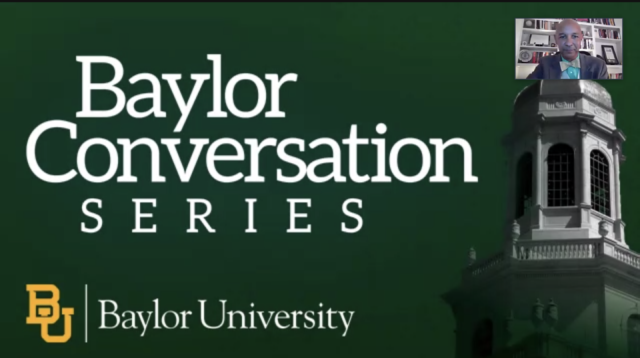By Emily Cousins | Staff Writer
A panel of historians discussed slavery in Texas and Baptist life in the second webinar in the three-part Baylor Conversation series, Perspectives on our History, Tuesday night.
One of the goals of the webinar series is to give context to the report made by the Commission on Historic Campus Representations before its release at the end of March.
Dr. Ronald Johnson, the Ralph and Bessie Mae Lynn Chair of History, moderated the panel’s discussion and said this conversation series is following the same path of history as the Commission on Historic Campus Representations.
“Last week, we addressed the history of slavery in America, and it was an engaged conversation with some very good questions submitted from the audience,” Johnson said. “Next Tuesday, during our last event, the conversation series will concentrate on the connections between slavery and the founding of Baylor University.”
Johnson asked the panelists, Dr. Mekala Audain, an associate professor of history at the College of New Jersey, Dr. Bill J. Leonard, founding dean and professor of divinity emeritus at Wake Forest University, and Dr. Michael Williams, a professor of history at Dallas Baptist University, how was the Bible used to justify slavery, particularly by Baptists?
Audain said the curse of Ham from the book of Genesis is one of the ways slaveholders justified enslaving Black people.
“It’s this idea that Black people, because they were descended from Ham, that they are deserving to be enslaved, and also that slavery would be good for Black people because it will teach them the hard work,” Audain said. “It will be a way to improve themselves through work, and so this idea that slavery wasn’t this terrible thing … Religion became a way to justify Black people’s existence in the United States.”
Leonard said Baptists and other American Christians deeply anchored their support for slavery in Scripture.
“Baptists took the Bible and used the Bible to support the cultural practice in which they found themselves,” Leonard said. “The Southern Baptists participated with Northerners in what was known as the triennial convention, the first large Baptist home and foreign Missionary Society, founded in 1840, and when that organization refused in 1845 to appoint a slaveholder … the Southern Baptists say that their missionary vision, [though] they never mentioned slavery, is being interfered with, so they have to form their own denomination. But the Southern Baptist Convention is founded out of a test case over the appointment of a slave-holding individual, and the abolitionist movement then prevails. And that’s with the split between Baptists North and South.”
Audain said after the Civil War, there was great resistance to Black freedom in Texas.
“As Black people gain more rights, white people respond with violence,” Audain said. “We see the rise of the Ku Klux Klan and other vigilante groups that are aimed to harm Black people who are voting or trying to register to vote or who are trying to own homes or start a business or become educated because these are markers that show that they’re moving farther away from enslavement.”
Audain said the confederate statues that currently sit all over the United States erected in the 20th century are a sign they are not there truly to memorialize the Confederacy.
“The statues are going up at a time of extreme violence against Black people,” Audain said. “The statues served as a reminder to Black people about their place in society even though they were free. These statues of the Confederate generals and Confederate heroes reminded them that white people didn’t believe that they were equal.”
Leonard said the development of “The Lost Cause” is how the true history of the Confederacy was rewritten.
“The re-mythologizing was the idea that even in defeat, the Southern people would be more Godly, more Biblical, more conservative, more loyal than their northern counterparts had been or ever would be,” Leonard said.
Williams said many Northerners became complicit because they wanted reunification for the United States.
“They were willing, then, to sacrifice on civil rights in order to promote this reunion taking place between the white South for the white-dominated South and the North,” Williams said. “There’s this almost universal white amnesia about really what the world was about. You see a glorification in the North of some of the so-called ‘great Christian heroes’ of the Confederacy, like Robert E. Lee and Stonewall Jackson.”
Johnson said he knows people will bring their own biases with them when they read the report made by the commission, but he hopes these conversations leading to the release will give context and more understanding.
“One can often say, ‘Slavery was so long ago, why are we still talking about it?’” Johnson said. “And I think it’s very important for us, particularly here at Baylor, to recall to mind that the legacy of slavery was not just that the university was built from money from slavery, in some cases by enslaved people themselves, but it led to a system of Jim Crow that did not allow students of color to come here until the 1960s. And so I think … talking about slavery and the legacy of slavery is really important to remind us that the problems we are dealing with are part of that system — that slavery is not gone all together. Its legacy remains with us.”
Johnson said he hopes people will start to see these conversations not as Black or white history, but as everyone’s history.
“We invite you all to join us next Tuesday for our last forum on the connections between slavery and the founding of Baylor University. Baylor University President Linda Livingstone will serve as a moderator,” Johnson said. “We hope to see you all then.”



